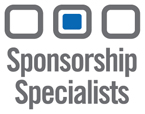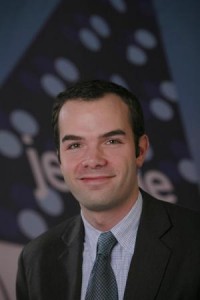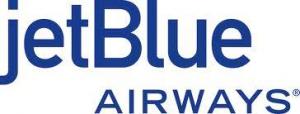Interview with JetBlue’s Sebastian White: Associations & Sponsorship
JetBlue’s Sebastian White Reflects on Associations, Nonprofits & Sponsorship Relationships
An Interview with Pamela Strother, Principal, Sponsorship Specialists
Today, we launch the first in series of interviews with people who make decisions on behalf of their companies to sponsor association and nonprofit events. Because I speak with many staff and Board leaders who feel daunted by the idea of talking to a big company about supporting their mission, I was inspired to make sure the voice of the sponsor was part of our “SponsorshipConversations.” I remind nonprofit and association leaders that companies don’t make decisions, people do. Building personal relationships is a critical element of a successful corporate sponsorship or partnership program. It’s also a deeply rewarding and often times quite fun experience to develop friendships and work together toward a common goal.
Sebastian White is a rising star in public relations and corporate communications. For the past five years, he has served as a spokesperson for JetBlue Airways.
I first met Sebastian in 2002 through an association-sponsored program (I was executive director of the National Lesbian & Gay Journalists Association at the time). A few worlds came together to make it possible for me to meet this dynamic young man:
1) college alumni networking (we both graduated from Alfred University)
2) a student program that met Sebastian’s professional aspirations, and,
3) the financial sponsorship by the nation’s top media outlets.
Sebastian and I have kept in touch over the years, but it is now nine years later and I am curious about what corporate sponsorship of associations and nonprofits have come to mean to him personally and how he applies this meaning in his role at JetBlue Airways.
First, a few more details about Sebastian. He attended Boston University and Alfred University (NY), where he studied economics and sociology. Sebastian joined JetBlue after three years with Carnegie Communications, a higher education marketing consultancy in Boston. While working primarily in communications, he is also active in JetBlue’s sponsorship of the National Lesbian & Gay Journalists Association (NLGJA). In addition, his work supports community promotions including JetPride, the first-ever LGBT-themed flight by a U.S. airline.
If you follow Sebastian on Twitter (@flyboyvancouver) you will find that “globetrotting jet-setter” is an understatement to describe his busy life with JetBlue Airways. You will also find someone who makes time for his friends and passions, including the Middle East, LGBT equality, and joie de vivre.
![]() Welcome to “SponsorshipConverstions” Sebastian. I really appreciate you taking the time to give our readers insights into your personal experiences with associations and corporate sponsorship and the program at JetBlue Airways.
Welcome to “SponsorshipConverstions” Sebastian. I really appreciate you taking the time to give our readers insights into your personal experiences with associations and corporate sponsorship and the program at JetBlue Airways.
I am always curious about someone’s first experience of benefiting from corporate sponsorship. What is your first memory of a corporate sponsor underwriting an experience that was meaningful to you? How did that make you feel about the company or business? About the sponsored organization or event?
![]() It was definitely the NLGJA Student Project in 2002. I arrived in Philadelphia not really knowing what to expect, nor knowing much about NLGJA. I thought it was a small grassroots organization. I remember being impressed at what seemed like an endless list of major media companies that were involved. I had no idea how influential NLGJA was until I saw names like CBS, ABC, Reuters and others lending their support. To me, the top feelings generated by the corporate sponsors were credibility and influence – it was exciting to be associated with this organization.
It was definitely the NLGJA Student Project in 2002. I arrived in Philadelphia not really knowing what to expect, nor knowing much about NLGJA. I thought it was a small grassroots organization. I remember being impressed at what seemed like an endless list of major media companies that were involved. I had no idea how influential NLGJA was until I saw names like CBS, ABC, Reuters and others lending their support. To me, the top feelings generated by the corporate sponsors were credibility and influence – it was exciting to be associated with this organization.
![]() Was your experience with the NLGJA Student Project your first association program experience? Did it influence your thinking about the role of associations in career development and professional development?
Was your experience with the NLGJA Student Project your first association program experience? Did it influence your thinking about the role of associations in career development and professional development?
![]() It was. I was a senior in college, and being there with such a lofty group of journalists kinda knocked me off of my feet. I went in thinking I was some sort of hot shot writer, and then I met all these volunteers from the different sponsoring organizations – people who were REAL journalists, and I realized I had a lot of work to do. It was a very self-conscious moment, but it made me redouble my efforts to be a better writer.
It was. I was a senior in college, and being there with such a lofty group of journalists kinda knocked me off of my feet. I went in thinking I was some sort of hot shot writer, and then I met all these volunteers from the different sponsoring organizations – people who were REAL journalists, and I realized I had a lot of work to do. It was a very self-conscious moment, but it made me redouble my efforts to be a better writer.
It’s not the kind of experience you normally get as a college student – it really made an impact. Now almost ten years later I’m still involved as a member of the association, a convention attendee and a sponsor. Although the organization itself has evolved tremendously, the support network that it provided to me as a 20-year-old and that made such an impact still remains. It is something I have been proud to have on my resume. When I came to JetBlue, I already knew people thanks to connections made at NLGJA.
A test: Do you remember who sponsored your NLGJA Student Project?
![]() I remember American Airlines flying in students from around the country in addition to CBS News and other news media organizations.
I remember American Airlines flying in students from around the country in addition to CBS News and other news media organizations.
![]() You are now on the other side, working on sponsorship relationships. What goes into that decision-making at JetBlue Airways? What do you feel makes relationships successful?
You are now on the other side, working on sponsorship relationships. What goes into that decision-making at JetBlue Airways? What do you feel makes relationships successful?
![]() Our Corporate Social Responsibility and Regional Marketing teams bucket our giving primarily in a few specific areas: health and wellness, education, environment, community and children/youth. I’m personally very interested in organizations that not only have a great mission but are actually producing results and have passionate people behind them – people who live and breathe for their organization or their cause. You know who these people are when you meet them.
Our Corporate Social Responsibility and Regional Marketing teams bucket our giving primarily in a few specific areas: health and wellness, education, environment, community and children/youth. I’m personally very interested in organizations that not only have a great mission but are actually producing results and have passionate people behind them – people who live and breathe for their organization or their cause. You know who these people are when you meet them.
For sponsorship applicants, those teams look at your issue area and if you are a match for our priority giving categories. Additionally, while we lend support to all the communities we serve; we tend to concentrate our giving in the markets where we are the biggest. We fly to 65 destinations, so while we are reaching more and more communities, cities like Boston and New York that see hundreds of flights a day will see more sponsorships than, say, a city with just a few flights a day. We tend to go where our flights and customers are.
Tip: Do your research. If your event is in Hawaii, remember that we don’t fly there!
While JetBlue usually focuses on supporting local organizations, we do have some long-standing partnerships with national organizations including KaBOOM!, First Book, American Cancer Society, DoSomething.org, and VH1 Save the Music Foundation.
![]() Do you track where your industry competitors are putting their sponsorship dollars? Do you prefer to go where they are or find your unique place?
Do you track where your industry competitors are putting their sponsorship dollars? Do you prefer to go where they are or find your unique place?
![]() A little of both. You will occasionally see us co-existing on sponsorship rolls with some of the other airlines depending on the cause or organization.
A little of both. You will occasionally see us co-existing on sponsorship rolls with some of the other airlines depending on the cause or organization.
However, we don’t want to be copycats. We want to find our own niche. In the LGBT space, for instance, we support NLGJA, but we’ve also focused on organizations that are doing good things to support kids. Groups like PFLAG, Love is Louder, and the Ali Forney Center here in our hometown of New York.
We also sponsor events that are important in specific communities but may not attract many other national companies such as the Utah Pride Festival in Salt Lake City. Did you know this is the 2nd largest event held in the state of Utah? With 2,000+ crewmembers (our word for employees) in Utah, it’s important to be there.
What are your top 1-3 pieces of advice for organizations that solicit corporate sponsorship?
![]() Understand that big companies are often inundated with proposals. Countless proposals cross our doorstep. A few years ago, I think we were seeing about 400 donation requests a week!
Understand that big companies are often inundated with proposals. Countless proposals cross our doorstep. A few years ago, I think we were seeing about 400 donation requests a week!
Timing does matter. Our various teams have a budget for the year so it is best to ask as early as possible, ideally before the start of the calendar year. As the year goes on, we just don’t have much flexibility.
Be responsive to your sponsors. We are in the customer service business and expect customer service from the organizations we support.
What are your top 1-3 pieces of advice you would give your peers, those who make decisions on behalf of corporations?
![]() Avoid quick decisions. While organizations may look great at first glance, you must always dig deeper and do a little research. Learn about a group’s history, its controversies, and its leaders. Do they have detractors? Why? You want to get the full picture. Even in my own personal life, I pour over Form 990’s from nonprofit organization to see how they’re spending money—even if it’s just a tiny donation; you don’t want your money wasted.
Avoid quick decisions. While organizations may look great at first glance, you must always dig deeper and do a little research. Learn about a group’s history, its controversies, and its leaders. Do they have detractors? Why? You want to get the full picture. Even in my own personal life, I pour over Form 990’s from nonprofit organization to see how they’re spending money—even if it’s just a tiny donation; you don’t want your money wasted.
What makes for a successful sponsor and nonprofit leader relationship in the context of JetBlue Airways?
![]() It’s really about client service. And I don’t mean sucking up to your donors. It’s really being thoughtful of their needs and how your organization can best support them. They’re investing a lot in terms of both time and money, so you have to make it worthwhile for them. That said, it’s a two-way street, though.
It’s really about client service. And I don’t mean sucking up to your donors. It’s really being thoughtful of their needs and how your organization can best support them. They’re investing a lot in terms of both time and money, so you have to make it worthwhile for them. That said, it’s a two-way street, though.
Touch base often and let us know about how your programs are going and how you are leveraging our brand and our partnership with you. Provide opportunities to meet and greet with your leaders and program recipients, even if that means going beyond our sponsorship contract.
On the charitable giving side, we don’t like a one-hit wonder where we show up for the big event and that’s the end of it. You won’t successfully form a long-term relationship with an organization that way.
If someone wants to connect with JetBlue Airways for a sponsorship, what is the best way to get started?
![]() We only accept online proposals. However, don’t tell anyone, but a hard copy mailing still gets attention, at least with me. I read all of my hard copy mail. If a great proposal is in there, I am going to share it with our marketing or CSR team.
We only accept online proposals. However, don’t tell anyone, but a hard copy mailing still gets attention, at least with me. I read all of my hard copy mail. If a great proposal is in there, I am going to share it with our marketing or CSR team.
Our website helps organizations get the lay of land of working with JetBlue. Check it out at: http://www.jetblue.com/about/promotions/about_promoGetSpons.html (Update 2012: http://www.jetblue.com/about/promotions/about_promoGetSpons.aspx)
![]() Thanks Sebastian, this is great information and I learned a lot about what is important to you, JetBlue Airways and your crewmembers.
Thanks Sebastian, this is great information and I learned a lot about what is important to you, JetBlue Airways and your crewmembers.
![]() Thank you. And I thank the readers of this blog for the work they do everyday on behalf of the nonprofit community. I wish we could support all of you!
Thank you. And I thank the readers of this blog for the work they do everyday on behalf of the nonprofit community. I wish we could support all of you!



